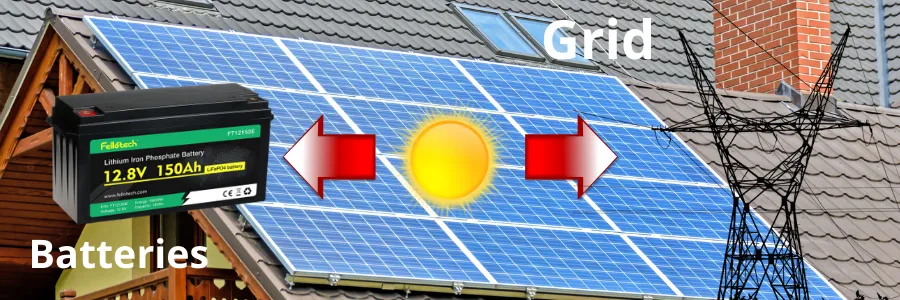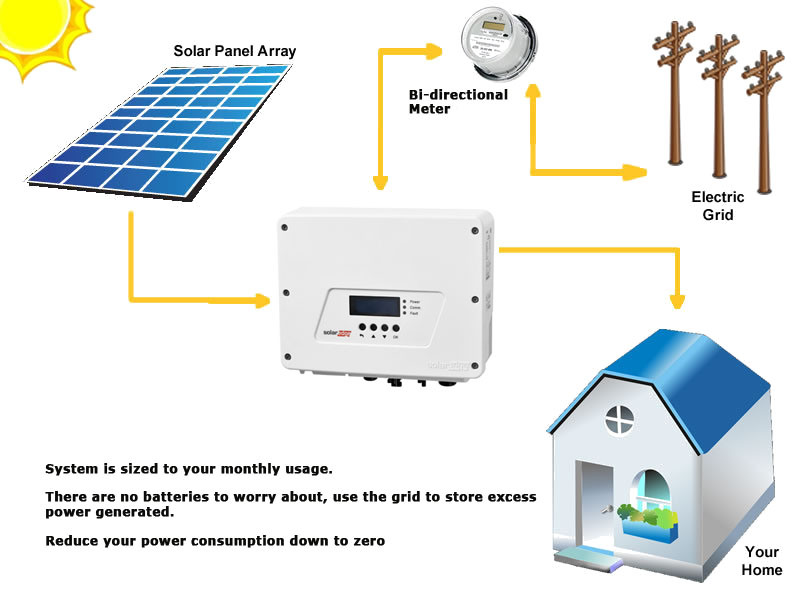The grid-tied system refers to a system that is connected to the local utility grid. The utility grid acts as as a huge energy reservoir, which saves buying costly batteries to back up excess solar energy production.
If the solar panel produces excess energy, the extra power is fed to the grid of your power company.
The excess solar energy allows you to build credit against future electricity use. Net metering is the name used to the equipment that controls this process.

An off-grid solar system operates independently of the utility company or grid power system. It is an autonomous option that gives you total control over your energy consumption and production.
The system is perfect for use in remote areas with no access to the utility grid, or for people who don’t want to depend on external power.
The biggest drawback of off-grid is that you must by backup batteries. Apart from being environmentally unfriendly, batteries are bulky and expensive.
How many solar batteries are needed to power a house?
You will need 10 LiFeP04 3.8kWh batteries to run a home with daily energy consumption of 30kWh (the U.S. daily average.) The number of solar batteries necessary to power a house depends on several factors:
- round-trip efficiency
- depth of discharge (DoD)
- power rating
- household energy used
Table – Calculate batteries needed for 30kWh/day home
| Backup For 24 Hours | Rating | Measurement Units |
| Total load for 24 hours backup | 30000 | Watt-hours (Wh) |
| Battery bank voltage | 48 | volts |
| Total amp-hour rating | 30000/48=625 | amp-hours (Ah) |
| Required Batteries (60% DOD) Lead-Acid | 583/0.6 = 1041 | Ah |
| Number of lead-acid batteries @250Ah each | 4 | |
| Required Batteries (80% DOD) Lithium Iron Phosphate | 583/0.8 = 729 | Ah |
| Number of Lithium batteries batteries @250Ah each | 3 |
What is round trip efficiency of battery?
It indicates the amount of energy a battery can supply as a percentage the amount it was charged with. You will lose
less energy for a battery-operated with high round-trip efficiency. A typical value is about 80% for lead-acid batteries.
What is battery depth of discharge?
It shows the amount of power that can be drawn from the battery without causing damage.
For solar energy storage, two basic types of battery are used:
- Deep-cycle lead-acid batteries
- Lithium iron phosphate batteries (LiFeP04)
Deep-cycle lead-acid batteries can be discharged up to 80% but 50% is normally advised to preserve the longest life.
LioFeP04 batteries can be discharge up to 95%, so this DoD represents a greater value for money.
What happens when solar batteries are full?
Most solar-focused batteries take less than a day to get to a full charge. When the battery is 100% charged, it ceases taking current from the solar system.
A lot of folks tend to worry about safety in the event of such an occurrence. That used to be a concern with the traditional lead-acid batteries, which produce hydrogen gas when overcharged.
Hydrogen gas is highly flammable, and a battery operated in this state could explode if not correctly installed.
Modern-day batteries incorporating lithium, are very safe. They do not emit any hydrogen gas, plus they get equipped with an in-built battery management system (BMS) to control charge and discharge values.

No responses yet